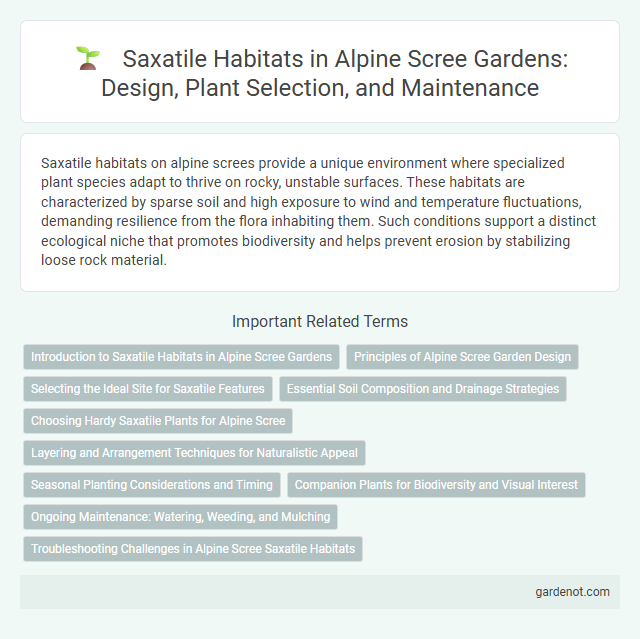Saxatile habitats on alpine screes provide a unique environment where specialized plant species adapt to thrive on rocky, unstable surfaces. These habitats are characterized by sparse soil and high exposure to wind and temperature fluctuations, demanding resilience from the flora inhabiting them. Such conditions support a distinct ecological niche that promotes biodiversity and helps prevent erosion by stabilizing loose rock material.
Introduction to Saxatile Habitats in Alpine Scree Gardens
Saxatile habitats in alpine scree gardens are characterized by rocky, well-drained slopes with sparse soil, providing a unique environment for specialized plant species adapted to harsh conditions. These habitats support a diverse range of saxicolous flora, including cushion plants, lichens, and hardy alpine species that thrive in nutrient-poor substrates and extreme temperature fluctuations. The microhabitats created by scree deposits offer critical refuges for endemic and rare plants, playing a vital role in alpine biodiversity and ecosystem stability.
Principles of Alpine Scree Garden Design
Saxatile habitats thrive in well-drained, rocky environments characteristic of Alpine scree, requiring careful attention to substrate composition and drainage in garden design. Incorporating angular scree and coarse gravel mimics natural conditions, promoting root stability and moisture regulation essential for saxatile plant health. Selecting native Alpine species with low nutrient demands and drought tolerance optimizes survival and ecological authenticity in alpine scree garden installations.
Selecting the Ideal Site for Saxatile Features
Selecting the ideal site for saxatile features in an alpine scree habitat involves identifying areas with stable, coarse rock debris and minimal soil development to support specialized flora. Optimal locations are typically well-drained slopes with abundant sun exposure, promoting the growth of saxatile plants adapted to harsh, nutrient-poor conditions. Prioritize sites with natural rock formations and microhabitats that retain moisture while preventing erosion, ensuring ecological balance and biodiversity.
Essential Soil Composition and Drainage Strategies
Saxatile habitats in alpine scree environments require well-drained, coarse-textured soils composed primarily of gravel, sand, and mineral fragments to support specialized plant life. The essential soil composition includes minimal organic matter, allowing rapid water percolation and preventing root waterlogging. Drainage strategies rely on soil porosity and slope gradient to facilitate efficient runoff, maintaining optimal moisture levels for saxatile vegetation sustainability.
Choosing Hardy Saxatile Plants for Alpine Scree
Hardy saxatile plants such as Saxifraga paniculata and Saxifraga cernua thrive in Alpine scree environments due to their ability to withstand harsh, rocky conditions and poor soil nutrients. Selecting species with deep root systems and drought resistance enhances survival rates on unstable scree slopes prone to erosion. Optimal growth of these saxatile plants contributes to soil stabilization and biodiversity in fragile alpine ecosystems.
Layering and Arrangement Techniques for Naturalistic Appeal
Layering in Saxatile habitats involves arranging rocks of varying sizes and textures to mimic natural scree slopes, promoting microhabitats for alpine flora and fauna. Strategic placement prioritizes stability and drainage, ensuring moisture retention while preventing erosion. This technique enhances ecological authenticity and supports biodiversity through carefully crafted rock formations.
Seasonal Planting Considerations and Timing
Seasonal planting in alpine scree environments within saxatile habitats demands careful timing to align with the brief growing season, typically spanning late spring to early autumn. Selecting native alpine species adapted to rapid development and freeze-thaw cycles enhances establishment success. Optimal planting occurs immediately after the last frost to maximize root development before colder temperatures resume.
Companion Plants for Biodiversity and Visual Interest
Saxatile habitats in alpine scree support diverse companion plants such as Saxifraga, Sedum, and Draba species, which enhance biodiversity and ecosystem stability. These plants adapt to rocky substrates and extreme conditions, creating microhabitats that sustain pollinators and soil microorganisms. Their varied textures and colors contribute to striking visual interest, enriching the alpine landscape's aesthetic appeal.
Ongoing Maintenance: Watering, Weeding, and Mulching
Ongoing maintenance of alpine scree in a saxatile habitat requires regular watering to mimic natural precipitation and sustain plant hydration. Persistent weeding prevents invasive species from competing with native alpine flora, crucial for preserving biodiversity and ecosystem balance. Mulching stabilizes soil temperature, retains moisture, and reduces erosion, supporting the fragile substrate typical of saxatile environments.
Troubleshooting Challenges in Alpine Scree Saxatile Habitats
Alpine scree saxatile habitats face challenges such as soil instability, extreme temperature fluctuations, and poor nutrient availability, hindering plant establishment and growth. Addressing issues of erosion control and microhabitat preservation is essential for maintaining biodiversity in these fragile ecosystems. Effective management strategies emphasize stabilizing rocky substrates and promoting native vegetation resilience to withstand environmental stressors.
Saxatile habitat Infographic

 gardenot.com
gardenot.com